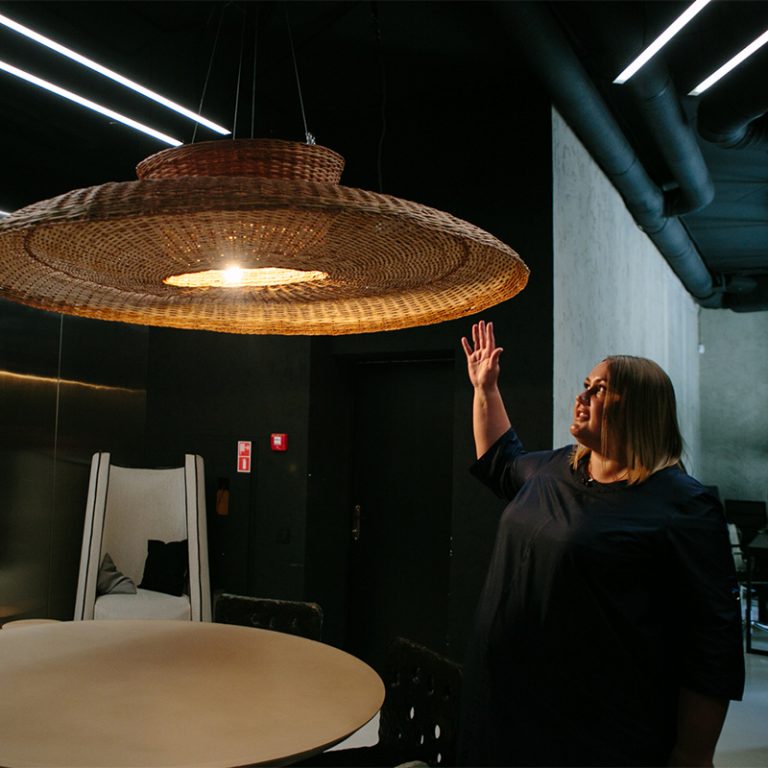In 2014, during the revolution of dignity, architect Viktoriia Yakusha felt the need to scale the Ukrainian cultural code globally, so she founded the Faina Live Design Brand. Since then, its furniture and other interior items have gained international recognition, and you can find them in galleries, homes, and offices in dozens of countries.
In the Faina collection, you can find a floor lamp called Soniah, vases called Bandura and Kumanec, a bed called Toptun (Soniah, Bandura, Kumanec, Toptun — these are transliterations of typical or commonly used Ukrainian words — ed.), Ztista products, and tapestries with ancient Trypillian symbols. Everything is made of eco-friendly materials in a minimalistic style with attention to the simplicity of forms. Before the Faina brand, Victoriia Yakusha was engaged in architecture and interior design. Since 2006, she has been the founder of Yakusha Design Studio. The designer explains what prompted her to expand her business and start a new branch in her studio:
“Faina is quite complex, has a difficult path, and not everyone can handle it. I often say that it chose me. That is, I did not sit and did not dream of going into industrial design, but sad events (2014 — ed.) pushed me to create something significant, iconic, with a Ukrainian code for the whole world.”
According to the founder, the first stage of creating a brand was the awareness of the idea itself, which came from the heart. Visiting exhibitions and knowing the trends, Victoriia Yakusha understood that her design approach is not like others. She has long since invested her time, energy, and money earned on architectural projects into Faina. The designer admits that her idea was often not supported, but she continued to believe in it despite doubts.
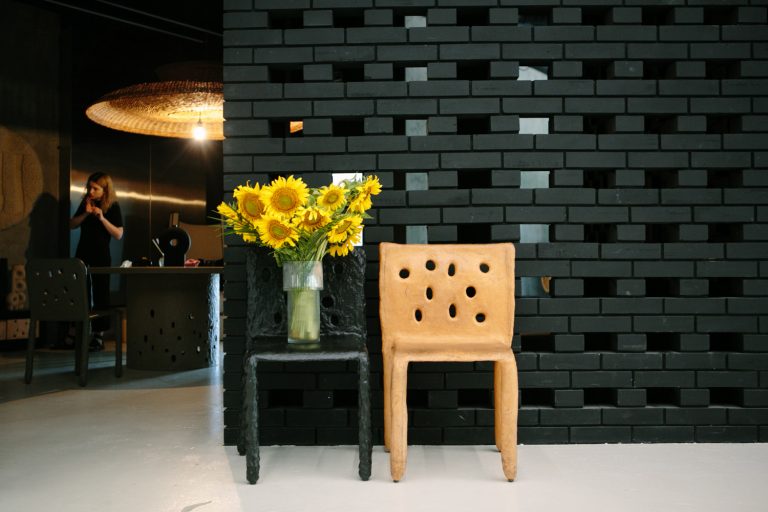
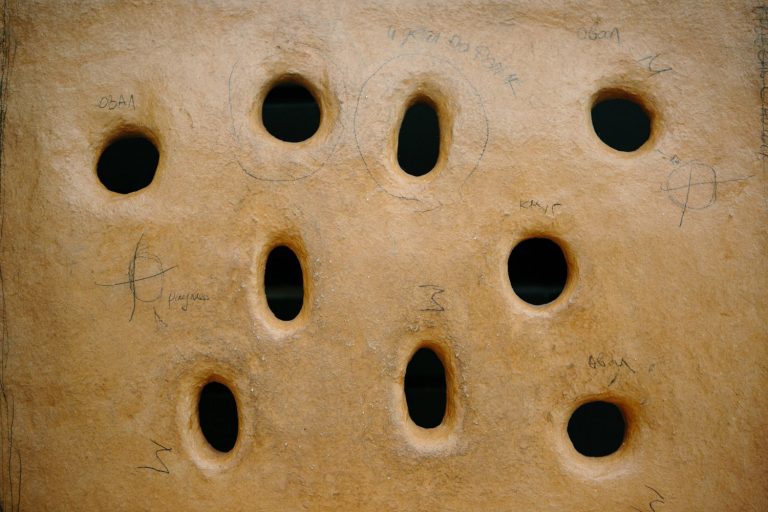
slideshow
Items with a history
Faina made home furniture, lighting, and fragrance collections in the style of live minimalism. This is the main idea and philosophy of the brand. According to the developer’s idea, Live Design is a connection with nature, your roots, and yourself.
“We pay great attention to the traditional production of our items. It is also about passing on history, but it is not only the country’s history. It is the history of the family and the person. Therefore, there is a lot of energy in our furniture, decor, and light. It is all alive.”
Environmental friendliness is one of the principles of Live Design Faina. The brand embodies it through the use of natural materials and natural fabrics. For Faina, this is not just fashionable but also important as a principle of sustainable development, indicating a conscious attitude to resources and the ability to leave something as a legacy.
“‘When you leave the office, does your furniture walk at night?’ we are frequently asked. Why do people ask that? Because when you look at them, they’re alive. It seems that this chair, aka “Toptun”, that it tramples, and it is all so alive.”

The story of Faina begins with a chair with embroidery. Then there was a chest of drawers with clay doors, which conquered more than one exhibition and has already been restored. The designer was inspired by Ukrainian culture, and so created the first items. She says that she once spent all her summer holidays with her grandparents in the village.
“It was a real childhood with real traditions. For example, Trinity Day or Ivana Kupala Day with wreaths.”
Faina furniture is stylized, transformed, and takes on modern forms, but its essence and history do not change.
“All the things we make tell you about Ukrainian life and traditions. For example, we have a vase called Trembita. We tell what a trembita is. It is the longest instrument, and so on. We tell who the bandura players are when we sell the Bandura vase. That is, we do such cultural diplomacy, but it is very intuitive for us.”
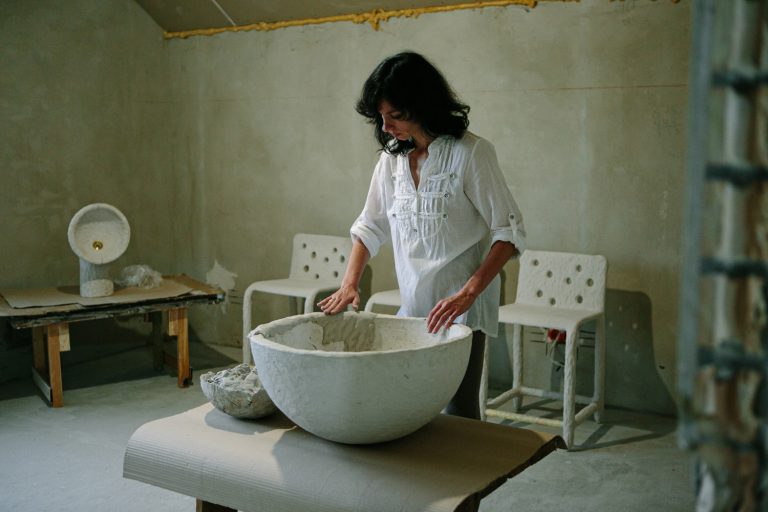
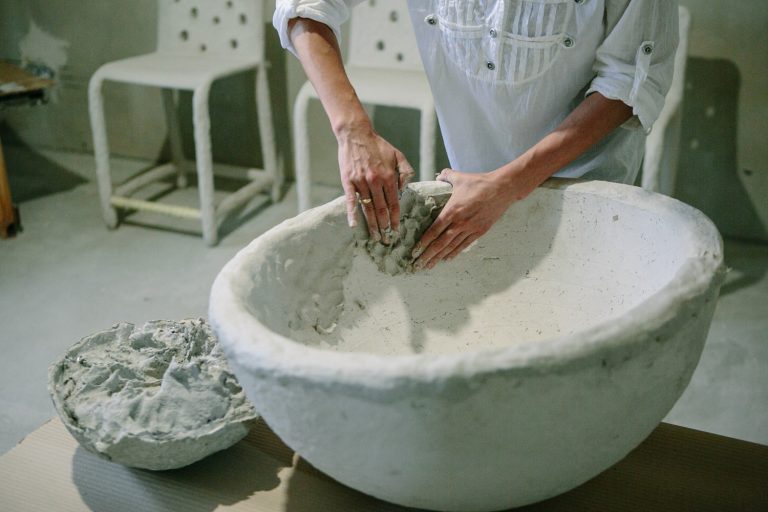
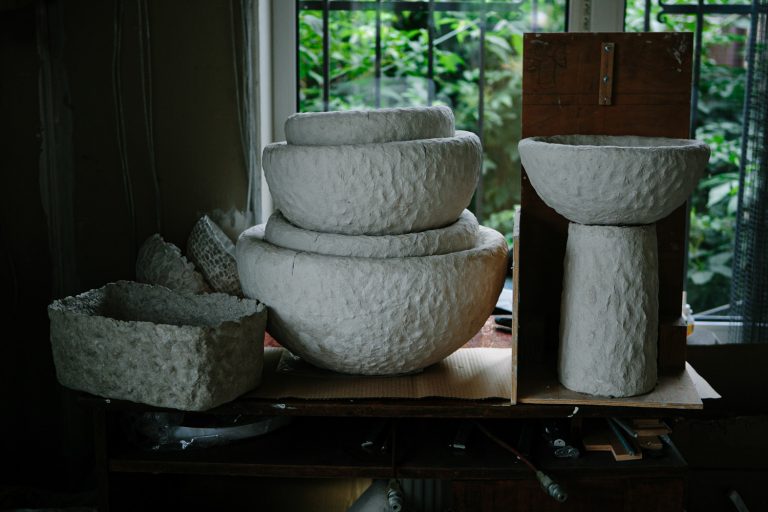
slideshow
Producing live furniture
Faina uses clay, natural fabrics, wood, etc. to make its products. This choice is also due to tactility, because the masters are meticulous, and the manufactured things are also pleasant to the touch.
In addition, Faina developed its own material, which is called “ztista”. It is a mixture of paper, flax, hemp, and bio-glue. The consistency of it resembles dough, and the masters work with it using the rolling method. Once, our ancestors were making mazanka houses this way.
Applying Ztista, Faina makes tables, chairs, and lamps called Soniah (which means sunflower in Ukrainian). This material is stuck to the metal frame of the product. All authentic items are integrated into modern interiors and emphasize such combinations:
“Here, for example, is our chest of drawers Pechyvo (“pechyvo” is a transliteration of the Ukrainian word for “cookie”). Its facades are like cookies. In general, when we talk about it somewhere at exhibitions or to our customers, they are so happy that they recognized this image: ‘Oh, so these are cookies!’.”
Each item goes through five to seven stages of production. First, is a design that corresponds to the author’s style, followed by a 3D visualization of the product and drawings based on prototypes. And only after that, the direct production of the client order begins: the drawings are given to contractors and craftsmen, who check every millimeter and shape. Despite possible difficulties in cooperation, Viktoriia Yakusha sincerely supports Ukrainian artisans, so she works with them:
“When we produced one of our first tables in Ukraine, it was eventually made by the seventh sculptor. When three or four millimeters do not converge, it is an entirely different shape.”

Faina’s team carefully approaches the presentation of materials from which furniture is made. The brand offers its customers a selection of samples, where it demonstrates the type of material, texture, and possible combinations:
“We have large boxes in which we put our fabrics, samples of “ztista”, and also show colors of wood or clay. We have even designed samples in our style so that they are very functional and visual.”
A reflection of Faina’s worldview is not only furniture and lighting but also fragrances. According to the founder of the brand, live design is everything that surrounds us:
“Have you ever wondered what the earth smells like? We worked on this with Ukrainian perfumers for nine months and invented this smell. We have three scents: wormwood, flower, and earth. The Earth is the most popular because it is very unusual. We expand and use everything that can reflect the worldview of live design.”

Design expeditions
To show the world Ukrainian traditions and crafts, Victoriia Yakusha decided to organize an expedition to invite the most influential experts in design and show them the Ukraine that inspires. The trip consists of various locations where participants get acquainted with national musical instruments (Trembita, Bandura) and participate in master classes in craft workshops (black Kosovo types of ceramics, pysankarstvo easter egg decorating). Two such expeditions have already taken place: in the fall of 2018 and in the summer of 2019. Among the guests were Roberto Bacoci — an Italian architect who makes Prada interiors and buildings around the world, and Anna Lina Leno, who is also called the Queen of Swedish design by editors of leading design publications.
Foreign guests were impressed by the Ukrainian artisans and their capabilities. While showing foreigners a part of Ukrainian culture, Viktoriia Yakusha wanted to prove to the locals that our crafts are unique and have a future in the present:
“For example, when we were on the Havarechchyna, we had a sculptor from England with us who was a fourth generation sculptor. He was amazed and said that there is no such thing anywhere because here you take clay from your yard, sculpt, bake, and sell it. In Europe, many places are engaged in crafts, and they are very much appreciated.”
In addition to the cultural presentation of Ukraine, the expedition also promotes the exchange of experience between masters. Victoriia recalls a Swedish designer who showed our craftsmen how to weave in a different way on the lizhnykarskyi machine ( Lizhnyky are woven hutsul blankets made of sheep’s wool). The expedition has given Ukrainians a better understanding of their own worth and uniqueness.
“This expedition has made a lot of sense. The artisans have grown up, and I saw that between the first and second expeditions. It is outside, and for us, so that Ukrainians can see that we are exciting and that our crafts, traditions, and forms are fascinating. You need to take all these crafts and add modernity, and it will grow.”

Working with the foreign market
From the moment the idea appeared in 2014 until 2018, Faina needed constant investment, but the team did not stop and continued learning. The brand started its career abroad with design exhibitions. At the first of them in Bologna, Italy, in 2015, Faina presented the Pechyvo chest of drawers, which customers were interested in. Still, the studio did not yet understand how to sell it. The team could not lead the customer in the product’s price and delivery, weight, and possible colors.
“It was an excellent situation to understand what stage you are at and that we had nothing at all but our idea. Having an idea is a very small thing.”
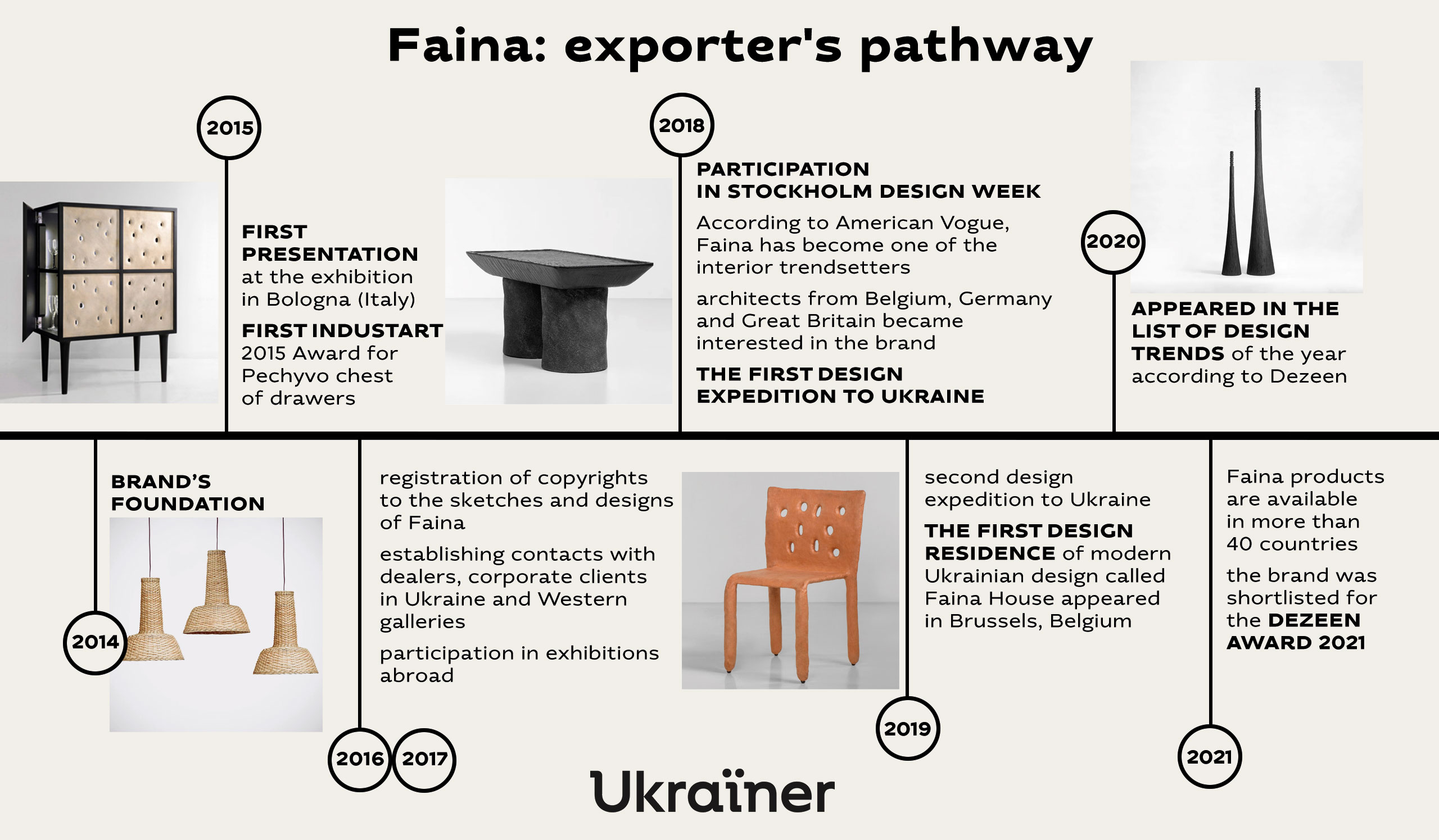
The next successful stage in the brand’s development was the international exhibition in Sweden, where Faina arrived in 2018. Then the local media wrote about Ukrainians. American Vogue included Faina in the top ten trendsetters in interior design. According to the founder, the team began to build a brand, understood its audience, and found a buyer from that moment on.
“Invitations to trend zones were very significant for us. One of the first was Stockholm Design Week, curated by Sahara Widoff, art director of Acne Studios. Then there was Studio Pepe in Milan, and we were also invited to participate. These events make us even more famous, and we get to stand next to the most influential and talented design experts, architects, or other participants. This is very interesting.”
Faina’s products are now presented in the Ya Vsesvit shop in Kyiv and Faina House design-residences in Brussels, Belgium. In 2019, Kyiv Space became one of the five best offices in the world and was shortlisted for the Design Award. In the Ya Vsesvit space, designed by Victoriia Yakusha, in addition to the Faina shop, there is also an office for Yakusha Design Studio, a lecture hall, and coworking space for representatives of the creative industries.

Now the team works worldwide, representing the brand in 44 countries and well-known trend books. You can find Faina’s products in the best design galleries in the USA, France, Great Britain, Italy, Sweden, and Switzerland. The brand is actively expanding its geography. According to Victoriia Yakusha, they do not wait for someone to write to them but knock on the galleries themselves and look for the best.
“You can see us in Hollywood, or here, for example, with Athena Calderone, a very influential design expert, who chose our products for her home.”
According to the founder, Faina started paying off in 2019. The brand describes its customer as someone who values individuality and does not buy mass-produced design. Victoriia tells us how a Swiss woman with Ukrainian roots reacted to the Bandura vase, feeling a certain kinship. When she found out that this was a Ukrainian brand, she flew to Milan for an exhibition to get acquainted with Faina.
“Foreign clients are very grateful that they know us at all, that we are so talented and unique, and that we brought our stuff to them, sent it, and showed them. That is a culture of gratitude and communication, from which you get positive emotions on both sides.”

Faina is also present in the Ukrainian market, but people buy it less actively. According to Victoriia Yakusha, an inferiority complex works here, which does not allow us to evaluate Ukrainian as high-quality and worthwhile. However, that doesn’t stop her:
“There are no such people as in Ukraine anywhere else because we do more than we can. We believe we are very fast and very talented. I do not regret it in any way, and it is very wonderful to work with Ukrainians.”
Victoriia Yakusha advises future designers not to design for the sake of design. The very first thing to do is define a mission.
“If I were starting out now and wanted to become an industrial designer, I would only do what improved the world. The first question you have to answer for yourself is why you are doing this and how it can improve the world. If it improves the world, do it. I think this is the most important piece of advice.”
supported by
This material was created with the support of the Swiss embassy in Ukraine. Ukrainer is solely responsible for the content. The opinion of the material creators does not necessarily reflect the views of the donor.


